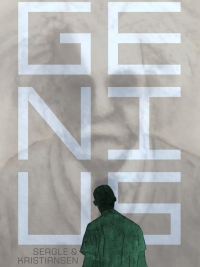Review of Two Recent Graphic Novels: Templar and Genius
- Reviewed by Wilson C. Freeman
- August 9, 2013
The two protagonists from these graphic novels — one a Knight Templar, another a struggling theoretical physicist — couldn’t be more different, but their stories will make you take notice.
For those unfamiliar with graphic novels, the books are a vehicle for “kids stories”; essentially long comic books for folks who like pictures with their tales of swashbuckling adventure and heroism. Many “real” fans of graphic novels push back against that characterization and can point to any number of highly sophisticated, literary works as evidence for the skeptics. But no matter which side of this “debate” you come from, hopefully you can agree that a good adventure story is welcome from time to time.
Templar, by Jordan Mechner, with art by LeUyen Pham and Alex Puvilland, is just such a story. Mechner’s name might sound familiar — he created the “Prince of Persia” line of video games, acclaimed and popular in their various iterations since the original, which Mechner developed in 1989 for the Apple II. Disney even adapted “Prince of Persia” into a major motion picture in 2010.
Mechner’s “Prince of Persia” stars a dashing warrior who runs, jumps and swordfights his way to safety, great treasure and occasionally a princess. Considered in broad strokes, Templar is not a deviation from this formula. But Mechner also picks up elements from movies — especially heist movies — and the vast wealth of fiction based on the Knights Templar to put together a story with surprising depth and excitement.
 |
TemplarJordan Mechner |
Templar takes place in the early 14th century during the destruction of the Knights Templar by King Phillip IV of France, following the adventures of a fictional Knight Templar named Martin. Martin’s love left him years ago to marry another, so he left to join the Templars and fight for God and glory in the Holy Land. Years later, he has returned to France with his brothers. As veterans of the Crusades, they expect to be welcomed as heroes. In the novel, as in real life, it was not to be. The King and his almost comically villainous advisor, Nogaret, conspire to ambush and imprison the Templars. Through blind luck, Martin escapes and finds out that the Templar’s treasure, pillaged from centuries of conquest in the Holy Land, has been hidden away somewhere in France.
This treasure represents the MacGuffin that drives the plot; Martin and friends race to find and get it out of France as the evil Nogaret tries to catch them or discover their plan. Mechner’s story hits all of the beats: Martin assembles a merry band of rogues, each with unique skills to contribute; they come up with a cunning plan to outwit the villain; Martin regains his honor and finds love in the process. There are really no surprises in Templar, but that’s not the point: the point is that this is an adventure story worthy of the blockbusters it borrows from. It is great fun, tough to put down, and is well paced and carefully researched. The art, too, is excellent. It makes great use of color and light, the characters are stylistic and memorable, and the city scenes do a good job of capturing the squalor and crush of 14th century urban life.
While Templar charges fearlessly into the comic-book-as-adventure-story trope, Steven T. Seagle and Teddy Kristiansen’s Genius stands calmly as the opposite extreme. Muted watercolors, relatable characters, and a touching and human story characterize this short graphic novel.
 |
GeniusSteven T. Seagle and Teddy Kristiansen |
Genuis tells the story (unsurprisingly) of a genius struggling with familiar problems. It might be more accurate to say that Ted is only a genius compared to us ordinary mortals — he’s a theoretical physicist working in one of the nation’s most competitive think tanks — but in the shadow of his hero, the quintessential genius, Albert Einstein, Ted seems absolutely ordinary. Ted struggles with this reality; he’s failing to meet his goals at work, he’s drifting apart from his wife and he’s losing touch with his children. Genuis attempts to show that no amount of IQ is enough to pass easily through the trials of adulthood. When Ted gets the opportunity to seemingly solve his problems by stealing from Einstein himself, his own identity — forever defined by his intellect — is placed at risk.
Genius is elegant. The message is forceful and humbling. The story is swift, and at 128 pages, goes by in the blink of an eye. The watercolor pages are muted but evocative; bright colors are rare but used well.
All that said, Genius has its flaws. The story is contrived almost to the point of silliness; it takes deliberate and predictable steps to make its point. There are few characters of note. Ted is the only memorable one — but it turns out that it’s very hard to like our protagonist. Until the telegraphed pivot at the end of the book, Ted seems aloof from everyone, selfish and occasionally callous. I want to like Ted because I’m told to like him, and he has people around him who seem to like him. But Genius could stand to spend a few more pages to develop Ted, and perhaps some of the supporting characters. This would have added considerably to the book’s already meaningful emotional depth.
Both Templar and Genius are graphic novels. But this is about all they have in common. One is a lengthy adventure story with bright colors, some comedy and daring heroes. The other is a short, human story, painted in grays and blues, about a man struggling with his identity in his middle age. Both are worthy of your attention.
Wilson Freeman is a lawyer currently working for the federal government. He appears to be the only man in Portland, Ore., who wears a tie.
